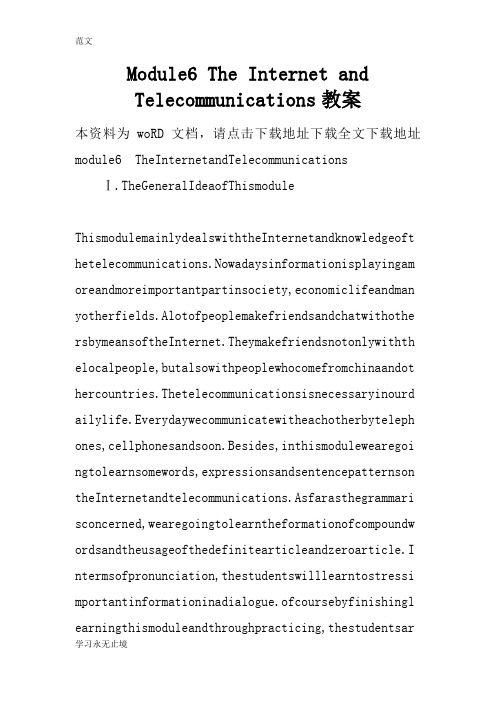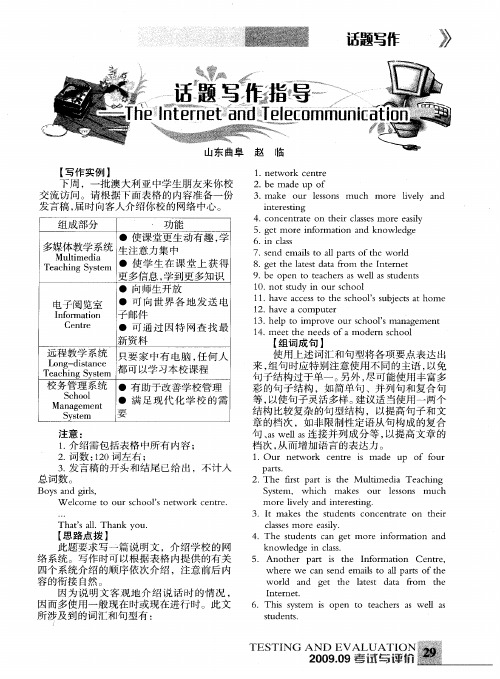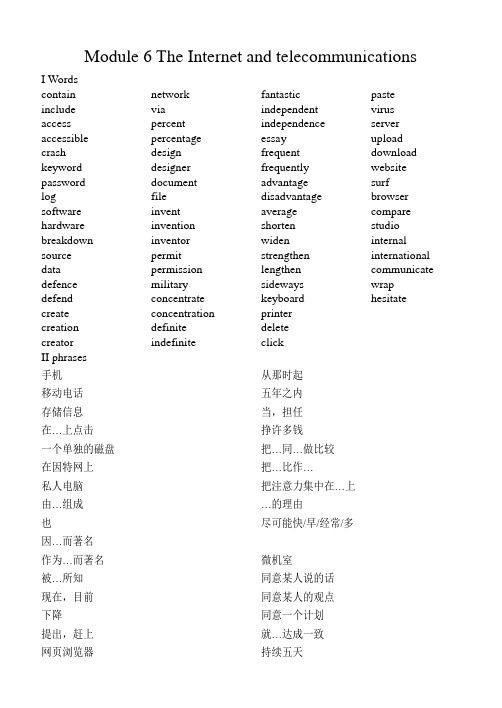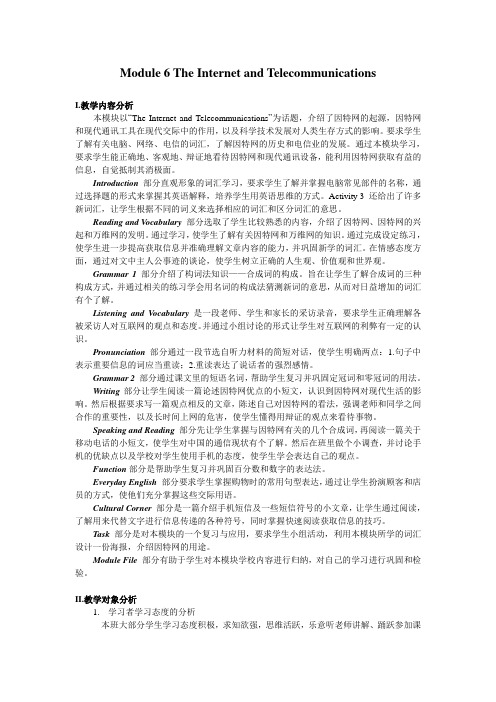the internet and telecommunication
- 格式:ppt
- 大小:2.20 MB
- 文档页数:19

The Internet and Telecommunications教案(通用4篇)The Internet and Telecommunications 篇1the internet and telecommunications教案module 6 the internet and telecommunications话题导入电脑网络是我们日常生活中的重要工具,如果没有了它,这个世界不知会变得如何?电脑网络能处理的事情太多了,衣、食、住、行、吃、喝、玩、乐、电子采购、电子公文交换、电子支付、电子保健、电子监理等等,都和电脑脱不了关系,它还能把事情整理得井井有条。
在以后的岁月中,不懂电脑网络的人很可能寸步难行!背景知识the first computer世界上第一台电子数字式计算机于1946年2月15日在美国宾夕法尼亚大学正式投入运行,它的名称叫eniac(埃尼阿克),是电子数值积分计算机(the electronic numberical integrator and computer)的缩写。
它使用了17468个真空电子管,耗电174千瓦,占地170平方米,重达30吨,每秒钟可进行5000次加法运算。
虽然它的功能还比不上今天最普通的一台微型计算机,但在当时它已是运算速度的绝对冠军,并且其运算的精确度和准确度也是史无前例的。
computer network将地理位置分散的计算机通过专用的电缆或通信线路互相连接,就组成了计算机网络。
网络可以使分散的各种资源得到共享,使计算机的实际效用提高了很多。
计算机联网不再是可有可无的事,而是计算机应用中一个很重要的部分。
人们常说的因特网(internet,也译为国际互联网)就是一个通过通信线路连接、覆盖全球的计算机网络。
通过因特网,人们足不出户就可获取大量的信息,与世界各地的亲友快捷通信, 进行网上贸易等等。
引入型阅读tim berners-lee and the internettim berners-lee is the man who wrote the software(软件) programme that led to the foundation of the world wide web.britain played an important part in developing the first generation(第一代) of computers.the parents of tim berners-lee both worked on on e of the earliest commercial(商业的) computers and talked about their work at home.as a child he would build models of computers from packaging material.after graduating from oxford university he went on to the real thing.in the 1980’s,scientists were already using a primitive version(原始版本) of e-mail.while working at a laboratory in swi tzerland tim berners-lee wrote a programme which let him store these messages.in 1990 he wrote the http(服务程序所用的协议) and html(超文本链接标示语言) programmes which formed the basis o f the world wide web.the next year his programmes were placed on to the internet.everyone was welcome to use them and improve them if they could.programmers used his codes(编码) to work with different operating systems (系统).new things like web browsers(浏览器) and search engines were developed.between 1991 and 1994 the number of web pages rose from 10 to 100 000.in 1994 tim berners-lee formed the newly-formed world wide web co nsortium(协会) or w3c.more than 200 leading companies and laboratories are represented(代表) by w3c.t ogether they make sure that everyone can participate(参加) equally on the web.1.the main idea of this passage is ______.a.when the internet appearedb.why computers develop so rapidlyc.how the world wide web startedc.how tim berners-lee formed w3c2.scientists began to use e-mails______.a.in the 1960’sb.before 1990c.after the 1980’sd.in 1980’s3.which of the following is not true ?a.the world wide web will have an effect on social development.b.the number of web pages rose very rapidly in the 1990’s.[.com]c.tim berners-lee made a great contribution to the compu ter science.d.tim’s programmes were placed on to the internet in 1990.答案:1.c 2.d 3.dThe Internet and Telecommunications教案篇2the internet and telecommunications教案典句精讲1.in 1969,darpa,a us defence organisation, developed a way for all their com puters to“talk”to each other through the telephon e.1969年,一个美国国防部的组织——darpa研发出了一种办法,用电话线路把其所有的计算机连接起来使其相互“对话”。

Module6 The Internet andTelecommunications教案本资料为woRD文档,请点击下载地址下载全文下载地址module6 TheInternetandTelecommunicationsⅠ.TheGeneralIdeaofThismoduleThismodulemainlydealswiththeInternetandknowledgeoft hetelecommunications.Nowadaysinformationisplayingam oreandmoreimportantpartinsociety,economiclifeandman yotherfields.Alotofpeoplemakefriendsandchatwithothe rsbymeansoftheInternet.Theymakefriendsnotonlywithth elocalpeople,butalsowithpeoplewhocomefromchinaandot hercountries.Thetelecommunicationsisnecessaryinourd ailylife.Everydaywecommunicatewitheachotherbyteleph ones,cellphonesandsoon.Besides,inthismodulewearegoi ngtolearnsomewords,expressionsandsentencepatternson theInternetandtelecommunications.Asfarasthegrammari sconcerned,wearegoingtolearntheformationofcompoundw ordsandtheusageofthedefinitearticleandzeroarticle.I ntermsofpronunciation,thestudentswilllearntostressi mportantinformationinadialogue.ofcoursebyfinishingl earningthismoduleandthroughpracticing,thestudentsarerequiredtoimprovetheirabilitiesoflistening,speakin g,readingandwriting.Besides,thestudentsshouldalsole arnsomestrategiesoflearning.INTRoDUcTIoNThreeactivitieshavebeendesignedinthispart.Itintrodu cessomewordsandexpressionsandtheirmeaningsontheInternet.Studentsarerequiredto befamiliarwiththesewordsandexpressionssothattheycan haveafurtherstudyofthismodule.READINGANDVocABULARyThispartmainlyintroducestheInternet,thesettingupoft heInternettous.Italsodealswiththeworldwidewebandthe inventionofit.Thestudentsareaskedtoknowsomethingabo uttheInternetandhaveaknowledgeoftheworldwidewebbyre adingtheparagraph.PostReadingandthedesigningoftheac tivitiesaimathelpingstudentstestiftheygettherelevan tinformationcorrectlyoriftheyhelpthemunderstandtheinformationfurther.GRAmmAR1Thissectionintroducesknowledgeofwordformation:thebu ildingofcompoundnouns.Thestudentsareaskedtoknowthef ormationofthethreetypesofcompoundnounsandthenconsol idatetheknowledge bydoingsomeexercisesinActivity1andActivity2.LISTENINGANDVocABULARywewillcompletetheexercisesonmultiplechoiceanddiscus sionbylisteningtoaTVinterview.Thelisteningmateriala imsatpracticingthestudents’listeningskillsandcomprehension.PRoNUNcIATIoNThissectionsuppliesashortdialogue,aimingatmakingthe studentsunderstandthatwordsofimportantinformationsh ouldproperlybestressedinaspecificsituation.GRAmmAR2Thissectionmainlyreviewstheusageofarticlesbycarryin goutthefouractivitieswhichhavebeendesigned.wRITINGThissectionrequiresthestudentstoreadtheshortessayde alingwiththeadvantagesofInternet.Andthenthestudents areaskedtowriteashortparagraphgivingtheoppositeview accordingtothewordsandexpressionsgiven.Besides,thep aragraphshoulddealwiththeimportanceofthehelpofthete achersandcooperationamongtheclassmates.SPEAkINGANDREADINGLearnseveralcompoundnounsaboutthetelecommunications .Readashortparagraphaboutmobilephones.Investigateth enumberofstudentswhousemobilephonesintheclass.Final lydiscussthequestionsgiven.FUNcTIoNReviewtheexpressingmethodsofpercentagesandnumbers.EVERyDAyENGLISHThispartmainlyreviewsthecommonlyusedsentencepattern sofshopping.cULTURALcoRNERGettoknowthatpeoplesendtextmessagesbymobilephones,a ndgettoknowthephenomenonofusingaseriesofsymbolstoshowhowtheyfeelandhowtoexp ressemotions.thesestudentsareabletoanswertherelevan tquestions.TASkworkingroupsoftwoormoretodesignaposter,introducingt heuseoftheInternet.moDULEFILESummarizethewordsandexpressions,grammar,pronunciati onandeverydayEnglishlearnedinthismodule.Ⅱ.Three-DimensionalGoals.knowledgeandSkillsBeabletomasterthekeywordsandexpressions,readthetext fluentlyandgettoknowsomethingabouttheInternetandtel ecommunications.Thestudentsareaskedtoknowsomeformsofcompoundwords.T heyaretomasterthebasicusagesofthedefinitearticleand zeroarticle.2.ProcessandmethodsLearnindependentlyandbeinstructedbytheteacher.Tryto haveaknowledgeoftheInternetandtelecommunications.Inquiryandactivity.Thestudentsarerequiredtoundersta ndhowtomakefriends,tostudyonlineanddoshoppingonline throughtheInternetandtelecommunications.Practiceofthinking.Trytogetthestudentstoknowcorrect lytherapiddevelopmentoftheInternetandtelecommunicat ionsandtheirfunctioninmoderncommunication.3.EmotionandValuesStudentsareaskedtolookattheInternetandmodernequipme ntoftelecommunicationsdialectically.Beabletouseacti velytheusefulresourcestoobtainanddealwithinformatio n.Trytomakethemworkfortheirstudyandlife.ofcourse,th estudentsmustavoidindulginginelectronicgames.Theymu stn’tspendalotoftimeonplayingcomputergames.Ⅲ.TeachingImportantPointsGettoknowandcomparetheusingoftheInternetandtelecomm unicationsinchinaandothercountries.Enablethestudent stograspthewordsandphrasesaboutcomputer,theInternet andtelecommunications.Andimprovethestudents’abilitiesofreadingcomprehensionandwriting.Ⅳ.TeachingDifficultPointHowtoimprovethestudents’abilitiesoflisteningandspeakinginteaching.Ⅴ.PreparationsofTeachingAidsAdeskcomputeroralaptop,multimediaandaslideprojectorⅥ.TeachingTimeSevenperiods.TheFirstPeriod:Introduction,VocabularyandSpeakingTheSecondandtheThirdPeriods:ReadingandVacabularyTheFourthPeriod:Grammar1,ListeningandVacabularyTheFifthPeriod:Pronunciation,Grammar2andwritingTheSixthPeriod:SpeakingandReading,Function,Everyday EnglishTheSeventhperiod:culturalcorner,TaskandmoduleFile,w orkbookExercisesTheFirstPeriodTheGeneralIdeaofThisPeriodInthisperiodwe’regoingtolearnvocabularyandtheEnglishdefinitionsont hepartsofthecomputer.Andthenwewillfinishthethreeact ivitiesonPage51andpractisespeakingEnglish.TeachingAims.Learnandmasterthefollowing:words:access,crash,keyword,log,software,breakdownPhrases:clickon,logon/off,computerhardware,computer software2.Developthestudents’speakingabilitybytalkinganddiscussing.TeachingImportantPoints.Trainthestudents’speakingability.2.masterthenewwordsandexpressions.TeachingDifficultPointHowtoimprovethestudents’speakingability.Teachingmethods.Individualorgroupwork.2.Explanationandpracticemethods.TeachingAids.acomputer2.aprojector3.theblackboardTeachingProceduresStep1GreetingsandLead-inT:Hello,everyone.Ss:Hello,teacher.T:Sitdown,please.NowinthisunitwearegoingtolearnsomethingabouttheInternetandtelecommunications.Firstofa ll,let’slearnthenewwordsandexpressions.HaveyoupreparedS:yes.T:ok.ZhangFang,pleasereadthenewwordsandexpressions.Step2PresentationT:First,let’slookatsomenewwordsandexpressions.access crash Internet presonal computerkeyword log website store softwarebreakdown email monitor hardware creditcardT:ok.Asyouknow,thecomputerisplayinganimportantparti nourdailylife.TheInternetisusedinalmost everyfieldofoursocietyandeconomics.canyoulabelthepicture withthewordsonPage51S:Iwanttohaveatry.T:ok.DoyouthinkwhatheansweredisrightT:Excellent.Nowlet’sdealwithExercise2.matchtheitemswiththeirdefinition s.Pleasethinkitover.T:Stophere,please.Nowlet’schecktheanswerswiththewholeclass.AreyoureadyS:yes.T:Allright,let’sbegin.keysforreference:→2→3→45→6Step3PracticeT:Nowlet’sdoExercise3.Pleasetrytogettheexactmeaningofthesewo rdsorphrasesonPage51.T:Pleaseanswerthequestionsaboutotherpossiblemeaningsofthewords.S:Surf.T:Right?yes,good.Next,please.S:wecanusetheword“crash”.T:Doyouthinkso?yeah,right.ThethirdoneS:Store.T:Rightorwrong?Right.Now,thefourthquestion.who’svolunteer?Liyuan,pleaseS:Ithinklogislengthoftree-trunkthathasfallenorbeenc utdown.Itcanalsobeusedasaverb,means:toenterinalog-b ook.Thephrasalverblogonmeans:toopenone’sonlineaccess toadatabase.Step4SummaryandHomeworkT:Inthisclasswe’velearntsomeusefulwordsandexpressionsoncomputersand theInternet.Andweknowthemainnamesofthepartsofthecom puter.what’smore,we’vegottoknowthedefinitionsofsomeofthecomputerterms.I hopeyoucanmasterthemafterclass.Pleasepreparefor“ReadingandVacabulary”.Somuchfortoday.Goodbye,eve ryone.xkb1Step5TheDesignofthewritingontheBlackboard module6 TheInternetandTelecommunicationsTheFirstPeriodmonitor access crash logon/off breakdown surf store websiteStep6ActivityandInquiryStepsStudents’ActingTeacher’sorganizing1&2Trytorecognizeandreadthenewwordsaccording totheillustration.Andunderstandthemeaningsofthevacabulary.Getthestudentstolabelthepicturewithaproperword3Finishdoing Activity 2.AndfindtheEnglishdefinitionsofeachnewword.Theteachercheckstheanswerswiththe wholeclass.。


Module 6 The Internet and telecommunications I Wordscontain include access accessible crash keyword password log software hardware breakdown source data defence defend create creation creator networkviapercentpercentagedesigndesignerdocumentfileinventinventioninventorpermitpermissionmilitaryconcentrateconcentrationdefiniteindefinitefantasticindependentindependenceessayfrequentfrequentlyadvantagedisadvantageaverageshortenwidenstrengthenlengthensidewayskeyboardprinterdeleteclickpastevirusserveruploaddownloadwebsitesurfbrowsercomparestudiointernalinternationalcommunicatewraphesitateII phrases手机移动电话存储信息在…上点击一个单独的磁盘在因特网上私人电脑由…组成也因…而著名作为…而著名被…所知现在,目前下降提出,赶上网页浏览器从那时起五年之内当,担任挣许多钱把…同…做比较把…比作…把注意力集中在…上…的理由尽可能快/早/经常/多微机室同意某人说的话同意某人的观点同意一个计划就…达成一致持续五天独立工作在某人看来在…的帮助下指出信用卡国内电话国际电话短信网上冲浪最大的移动电话市场做一个调查与…交流某人对…的态度把…包起来对做某事犹豫不决避免干某事一系列的做报告保持生态平衡一张笑脸用完,用尽不要紧,没关系对某人的健康有影响如何处理这个问题(2)伤害某人的感情取出III Sentences1、他发现独自做出这道题很困难。


Module 6 The Internet and TelecommunicationsI.教学内容分析本模块以“The Internet and Telecommunications”为话题,介绍了因特网的起源,因特网和现代通讯工具在现代交际中的作用,以及科学技术发展对人类生存方式的影响。
要求学生了解有关电脑、网络、电信的词汇,了解因特网的历史和电信业的发展。
通过本模块学习,要求学生能正确地、客观地、辩证地看待因特网和现代通讯设备,能利用因特网获取有益的信息,自觉抵制其消极面。
Introduction 部分直观形象的词汇学习,要求学生了解并掌握电脑常见部件的名称,通过选择题的形式来掌握其英语解释,培养学生用英语思维的方式。
Activity 3 还给出了许多新词汇,让学生根据不同的词义来选择相应的词汇和区分词汇的意思。
Reading and V ocabulary 部分选取了学生比较熟悉的内容,介绍了因特网、因特网的兴起和万维网的发明。
通过学习,使学生了解有关因特网和万维网的知识。
通过完成设定练习,使学生进一步提高获取信息并准确理解文章内容的能力,并巩固新学的词汇。
在情感态度方面,通过对文中主人公事迹的谈论,使学生树立正确的人生观、价值观和世界观。
Grammar 1 部分介绍了构词法知识——合成词的构成。
旨在让学生了解合成词的三种构成方式,并通过相关的练习学会用名词的构成法猜测新词的意思,从而对日益增加的词汇有个了解。
Listening and V ocabulary 是一段老师、学生和家长的采访录音,要求学生正确理解各被采访人对互联网的观点和态度。
并通过小组讨论的形式让学生对互联网的利弊有一定的认识。
Pronunciation部分通过一段节选自听力材料的简短对话,使学生明确两点:1.句子中表示重要信息的词应当重读;2.重读表达了说话者的强烈感情。
Grammar 2 部分通过课文里的短语名词,帮助学生复习并巩固定冠词和零冠词的用法。
The Internet and Telecommunications教案TheInternetandTelecommunications教案典句精讲.In1969,DARPA,aUSdefenceorganisation,developeda wayforalltheircomputersto“talk”toeachotherthroughthetelephone.969年,一个美国国防部的组织——DARPA研发出了一种办法,用电话线路把其所有的计算机连接起来使其相互【巧解句构】该句中foralltheircomputerto“talk”toeachotherthroughthetelephone作way的定语。
DARPA是AdvancedResearchProjectsAgency的缩写,意指(美国国防部)高级研究计划署。
2.Itthenbecamepossibleforuniversitiestousethesystem aswell.就在那个时候,美国的大学也能够使用这种网络系统了。
【巧解句构】aswellas与aswell同义,但常用来连接成分,连接两个主语时,谓语动词的数和第一个主语一致。
youaswellasIareright.我是对的,你也是对的。
3.Theworldwideweb(theweb)isacomputernetworkthatallowscomputeruserstoaccessin formationfrommillionsofwebsitesviatheInternet.万维网是一种计算机网络,它允许计算机用户通过因特网从数百万计的网站【巧解句构】该句中含有一个that引导的定语从句,先行词为computernetwork。
不定式短语toaccessinformationfrommillionsofwebsitesviatheInte rnet作computerusers的宾语补足语。
Module6 The Internet and Telecommunications教案Module 6 The Internet and Telecommunications Ⅰ.The General Idea of This Module�� This module mainly deals with the Internet and knowledge of the telecommunications. Nowadays information is playing a more and more important part in society, economic life and many other fields. A lot of people make friends and chat with others by means of the In ter They make friends not only with the local people, but also with people who come from China and other countries. The telecommunications is necessary in our daily life. Every day we communicate with each other by telephones, cell phones and so on. Besides, in this module we are going to learn some words, expressions and sentence patterns on the Internet and telecommunications. As far as the grammar is concerned, we are going to learn the formation of compound words and the usage of the definite article and zero article. In terms of pronunciation, the students will learn to stress important information in a dialogue. Of course by finishing learning this module and through practicing, the students are required to improve their abilities of listening, speaking, reading and writing. Besides, the students should also learn some strategies of learning.��INTRODUCTION �� Three activities have been designed in this part. It introduces some words and expressions�� and their meanings on the Inter Students are required to be familiar with these words and expressions so that they can have a further study of this module. ��READING AND VOCABULARY ��This part mainly introduces the Internet, the setting up of the Internet to us. It also deals with the World Wide Web and the invention of it. The students are asked to know something about the Internet and have a knowledge of the World Wide Web by reading the paragraph. Post Reading and the designing of the activitiesaim at helping students test if th ey get the relevant information correctly or if they help them understand the information further. �� GRAMMAR 1 �� This section introduces knowledge of word formation: the building of compound nouns. The students are asked to know the formation of the three types of compound nouns and then consolidate the knowledge ��by doing�� some exercises in Activity 1 and Activity 2.���� LISTENING AND VOCABULARY �� We will complete the exercises on multiple choice and discussion by listening to a TV interview. The listening material aims at practicing the students’ listening skills and comprehension. ��PRONUNCIATION ��This section supplies a short dialogue, aiming at making the students understand that words of important information should properly be stressed in a specific situation. ��GRAMMAR 2 ��This section mainly reviews the usage of articles by carrying out the four activities which have been designed. �� WRITING �� This section requires the students to read the short essay dealing with the advantages of Inter An d then the students are asked to write a short paragraph giving the opposite view according to the words and expressions given. Besides, the paragraph should deal with the importance of the help of the teachers and cooperation among the classmates. �� SPEAKING AND READING �� Learn several compound nouns about the telecommunications. Read a short paragraph about mobile phones. Investigate the number of students who use mobile phones in the class. Finally discuss the questions given. �� FUNCTION �� Review the expressing methods of percentages and numbers. ��EVERYDAY ENGLISH ��This part mainly reviews the commonly used sentence patterns of shopping. ��CULTURAL CORNER �� Get to know that people send text messages by mobile phones, and get to know thephenomenon�� of using a series of symbols to show how they feel and how to express emotions. these students are able to answer the relevant questions. �� TASK �� Work in groups of two or more to design a poster, introducing the use of the Inter �� MODULE FILE �� Summarize the words and expressions, grammar, pronunciation and everyday English learned in this module.����Ⅱ.Three-Dimensional Goals �� 1.Knowledge and Skills �� (1) Be able to master the key words and expressions, read the text fluently and get to know something about the Internet and telecommunications. �� (2) The students are asked to know some forms of compound words. They are to master the basic usages of the definite article and zero article. �� 2.Process and Methods �� (1) Learn independently and be instruc ted by the teacher. Try to have a knowledge of the Internet and telecommunications. �� (2) Inquiry and activity. The students are required to understand how to make friends, to study online and do shopping��online�� through the Internet and telecommunications. �� (3) Practice of thinking. Try to get the students to know correctly the rapid development of the Internet and telecommunications and their function in modern communication. �� 3.Emotion and Values �� Students are asked to look at the Internet and modern equipment of telecommunications dialectically. Be able to use actively the useful resources to obtain and deal with information. Try to make them work for their study and life. Of course, the students must avoid indulging in electronic g ames. They mustn’t spend a lot of time on playing computer games.����Ⅲ.Teaching Important Points �� Get to know and compare the using of the Internet and telecommunications in China and other countries. Enable the students to grasp the words and phrases about computer, theInternet and telecommunications. And improve the students’ abilities of reading comprehension and writing.����Ⅳ.Teaching Difficu lt Point ��How to improve the students’ abilities of listening and speaking in teaching.����Ⅴ.Preparat ions of Teaching Aids �� A desk computer or a laptop, multimedia and a slide projector����Ⅵ.Teaching Time �� Seven periods. �� The First Period: Introduction, Vocabulary and Speaking�� The Second and the Third Periods: Reading and Vacabulary �� The Fourth Period: Grammar 1, Listening and Vacabulary��The Fifth Period: Pronunciation, Grammar 2 and Writing�� The Sixth Period: Speaking and Reading, Function, Everyday English�� The Seventh period: Cultural Corner, Task and Module File, Workbo ok Exercises The First Period�� The General Idea of This Period�� In this period we’re going to learn vocabulary and the English definitions on the parts of the computer. And then we will finish the three activities on Page 51 and practise speaking English.�� Teaching Aims�� 1. Learn and master th e following: Words: access, crash, keyword, log, software, breakdown ��Phrases: click on, log on/off, computer hardware, computer software ��2. Develop the students’ speaking ability by talking and discussing. �� Teaching Important Points��1. Train the students’ speaking ability.�� 2. Master the new words and expressions.�� Teaching Difficult Point��How to improve the students’ speaking ability.��Teaching Methods�� 1. Individual or group work. �� 2. Explanation and practice methods.�� Teaching Aids�� 1. a computer ��2. a projector ��3. the blackboard��Teaching Procedures �いcStep 1 Greetings and Lead-in �� T: Hello, everyone.��Ss: Hello, teacher.��T: Sit down, please. Now in this unit we are go ing to learn something about the Internetand telecommunications. First of all, let’s learn the new words and expressions. Have you ��prepared��?�� S: Yes.�� T: OK. Zhang Fang, please read the new words and expressions. �いcStep 2 Presentation�� T: Fi rst, let’s look at some new words and expressions.��(Show the following on the screen.)�� access crash Internet presonal computer keyword log website store software breakdown email monitor hardware credit card (Teacher teaches the words and ��explains�� them; then says the following.) T: OK. As you know, the computer is playing an important part in our daily life. The Internet is used in almost ��every��field of our society and economics. Can you label the picture with the words on Page 51?�� S: I want to have a try. ��(Give the answer to Exercise 1.)�� T: OK. Do you think what he answered is right?��T: Excellent. Now let’s deal with Exercise 2.Match the items with their definitions. Please think it over.�� (The students prepare for this exercise for two minutes.) T: Stop here, please. Now let’s check the answers with the whole class. Are you ready?�� S: Yes.�� T: All right, let’s begin. ��(The teache r asks 6 students to match the items one by one. Then check their answers.)�� Keys for reference: ��1→(c) 2→(e)3→(b)4→(d)��5→(f)6→(a)�いc Step 3 Practice��T: Now let’s do Exercise 3.Please try to get the exact meaning of these words or phrases on Page 51.�� (Ss try to look them up in the dictionary or in the Student’s Book.) T: Please answer the ques tions about other possible meanings of the words.��S: Surf.��T: Right?Yes, good. Next, please.�� S: We can use the word “crash”.��T: Do you think so?Yeah, right. The third one?�� S: Store.�� T: Right or wrong? Right. Now, the fourth question. Who’s volunteer? Li Yuan, please S: I think log islength of tree-trunk that has fallen or been cut down. It can also be used as a verb, means: to enter (facts)in a log-book. The phrasal verb log on mean s: to open one’s online��access�� to a database. �いcStep 4 Summary and Homework��T: In this class we’ve learnt some useful words and expressions on computers and the Inter And we know the main names of the parts of the computer. What’s more, we’ve got to know the definitions of some of the computer terms.I hope you can master them after class. Please prepare for “Reading and Vacabulary”. So much for today. Goodbye, everyone.xkb1 �いcStep 5 The Design of the Writing on the Blackboard ��Module 6 The Internet and��Telecommunications�� The First Period�� monitor access crash log on/off breakdown surf storewebsite���c Step 6 Activity and Inquiry StepsStudents’Acting Teacher’s Organizing1 &2 Try to recognize and read the new words ��according��to the illustration. And understand the meanings of the vacabulary. Get the students to label the picture with a proper word3 Finish doing ��Activity�� 2.And find the English definitions of each new word. The teacher checks the answers with the whole class.优品课件,意犹未尽,知识共享,共创未来!!!。
Module6 The Internet and TelecommunicationSection1 Introduction &Reading and vocabulary 说课稿一、说教材(一)教材内容分析我说课的内容是外研版《英语》(新标准)高中第一册(必修1)Module6 The Internet and Telecommunication的Introduction &Reading and vocabulary 。
本模块以The Internet and Telecommunication为话题,介绍因特网和电信的迅猛发展及其在现代交际中的作用,旨在通过模块的教学使学生在教师的帮助下正确运用所学词汇和技能就这一内容发表自己的看法和见解;促进学生正确认识和积极使用因特网获取信息,使因特网服务于学习和生活。
Introduction部分主要是关于电脑部件和网络的词汇学习,以此作为Reading and V ocabulary 的热身,目的是让学生在接下来的阅读理解和词汇学习课中作好充分的准备;Reading and V ocabulary部分是关于介绍因特网和万维网发展史的阅读文章,教师应带领学生学习文章中的词汇以此降低文章难度,便于学生更加容易理解文章。
然后进行阅读理解训练,通过略读和精读从总体上把握文章结构并理解文章细节后,再次通读全文并学习文中的语言知识点。
(二)教学目标根据《新课标》总目标的描述,结合本课的内容,我把本节课的教学目标系统化,分别是:语言知识,能力目标,情感目标,文化意识,和学习策略。
1. 语言知识目标掌握并能运用下列词汇:monitor screen mouse CD-ROM keyboard hard disk access click on crash download email hardware Internet keyword log on/off modem personal computer software store surf website...2、语言技能目标能指出电脑主要部件和因特网常用相关词汇;能识别所学词语和结构并听懂它们所在句子和段落的意义;能理解含有本模块词语和结构的句子、段落并获取信息;对阅读内容进行预测、理解、对比、分析、综合,提高阅读能力。
The Internet and Telecommunication端氏中学:陈金丽三维目标1.Knowledge and skills1).Learn some vocabularies about computers, network, telecommunication and the history of the World Wide Web.2).Help students to make a summary of some s of the Internet in our daily life.3).Let students have a right attitude towards the Internet, and make the most of it, making it serve us well.2.Process and methods1).Individual work or pair work to get every students to participate in class2).Fast reading to make the students get the main idea of the passage.3.Emotion and ValuesTry to raise the students’cooperation awareness in their study by pair work and group work.Request the students to love science ,especially IT.教学重点1.Encourage the students to talk about computers as well as the internet.2.Help the students make sense of the passage3.Help the students to improve their reading ability.教学难点How to help students to talk about the different s that the Internet has in our society. 教具准备Multi-media and a tape-recorder.教学过程与安排意图Step1. Greeting and lead-inShow some pictures on the screen about the ways that the Internet is used in modern society.展示图片,讨论因特网在现代社会各个领域的用途,为阅读部分做好准备。